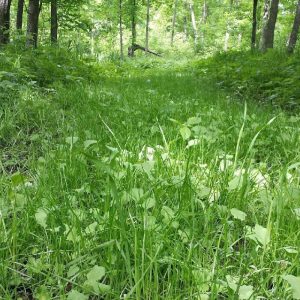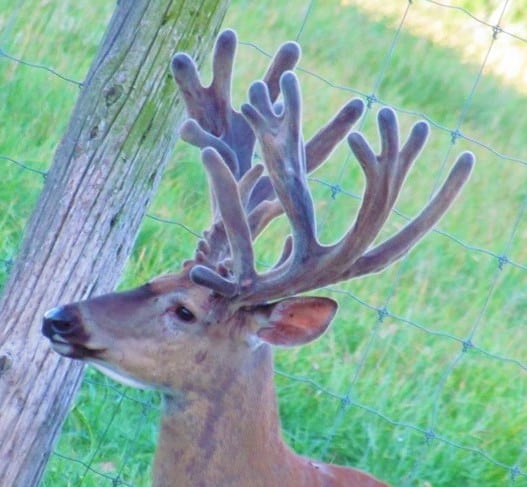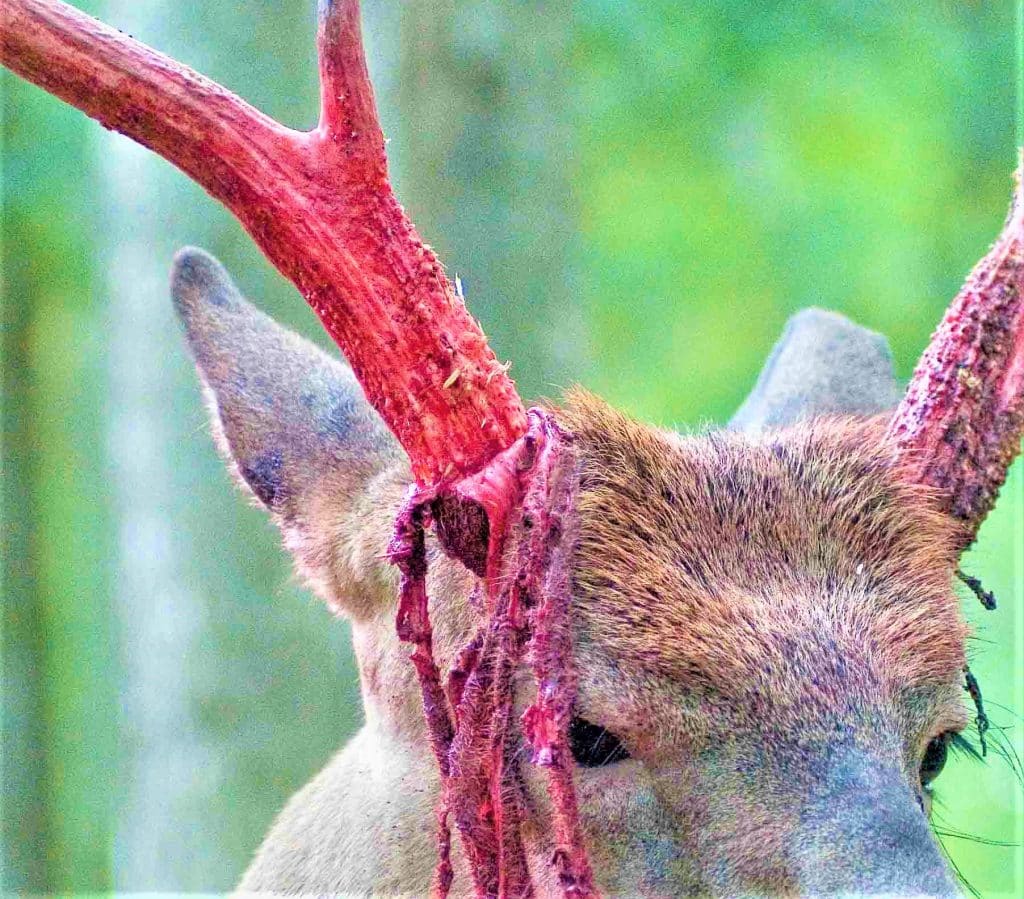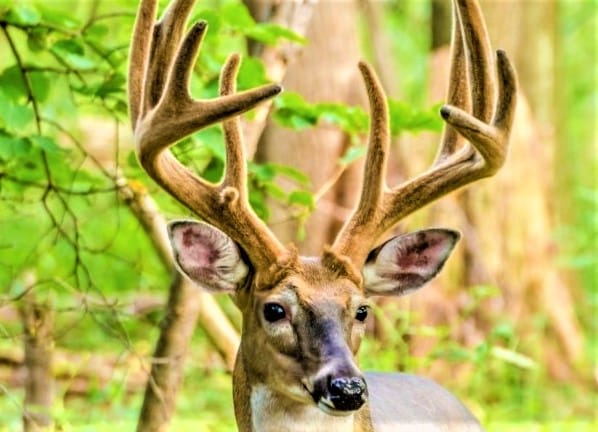Watching a buck shed it’s velvet is one of the most fascinating things I’ve ever seen. Growing bone outside their body and shedding the living tissue that surrounds it is an amazing thing. During their growth phase antlers form velvet like tissue that’s soft to the touch. But what is velvet and why do bucks shed it?
Why Do Bucks Peel Their Velvet?
What is Antler Velvet Anyway?
As bucks mature their antlers lengthen and thicken growing into those beautiful antlers you see during the hunting season. Most antlers will grow up to a half inch per day during the growth phase. It’s actually a modern marvel and one of the fastest-growing bones on the planet. With all that growth they need some way to supply energy.
Antlers are surrounded by living tissue that’s known as velvet. The velvet includes all of the nutrients that the buck needs to grow strong thick antlers. Velvet contains many substances needed to grow including amino acids, proteins, minerals and growth hormones.
Make Your Hunting Property Better To Increase Antler Size
 A bucks hard antlers are made up of mostly protein and various minerals. If you notice bucks in your heard that have weak antlers you might want to step up your deer management strategy.
A bucks hard antlers are made up of mostly protein and various minerals. If you notice bucks in your heard that have weak antlers you might want to step up your deer management strategy.
You’re going to want to provide more protein and minerals to strenthen the local deer herd. You’d be surprised just how much $20-30 worth of supplies will actually change a deer population. So what all do you need to increase antler growth?
Food Plots:
Setting up a small food plot will not only increase the size of your favorite bucks antlers, it will also drive in a ton of new deer. With a small quarter acre food plot you’ll definitely see a ton of deer throughout the summer.
When there’s deer in the summer they’ll be in the same general area during the hunting season. Every year I plant a bag of Antler King’s No Plow Food Plot Mix.
Planting a food plot is about as easy as you can get. Just sprinkle some seed on the ground, and before you know it you’ll have plants that deer love. With a variety of Oats, rye, brassica and clover bucks won’t be able to resist a small 1/4 acre buffet.
Protein and Mineral Pellets:
If you don’t think you have enough land to plant a small food plot you can still increase antler growth. By throwing a small bag of protein and mineral pellets in a feeder you’ll notice sizable improvements come hunting season.
Bucks are attracted to easy food sources. Just keep them feeling safe and they’ll keep coming around. This year I threw out a bag of Whitetail Institute’s 30-06 Mineral and Protein Supplements and I’ve noticed quite a few big bucks hanging around.
Mineral Licks:
Whether or not mineral licks work to improve antler size is debatable, but they’re definitely worth using. Mineral licks are like candy to growing bucks and even if they don’t improve antler size it’s always nice to see a few extra bucks hanging around.
Almost every mineral lick is basically the same, don’t let product manufacturers tell you anything differently. I think every hunter has at sometime in their life licked a mineral lick to see what all the fuss is about. Every single one tastes just like a big block of salt. I’ve been using Mighty Deer Licks Sweet Apple Block for no other reason than the fact that it’s cheaper than the competition and works.
When do Antlers Grow?
Antler growth starts in March and they’ll continue to grow throughout the summer. By July mature deers add up to an inch of antler growth per day.
Towards the end of summer there are a lot of fascinating changes that are occuring in the whitetail world. Summer is a time of leisure for whitetails, when all they have to worry about is natural predators.
Life is good and about as easy as it gets. There’s a lot of food and water available which allows bucks to group up and look for their fall and winter bedding Area.

How do Antlers Grow
The antlers will grow rapidly for a few months during the spring and summer. Normally after 2 to 4 months bucks get an increase of testosterone which slows the antler growth.
Without future growth the velvet is no longer needed and the velvet constricts and cuts off blood flow. Withering and falling off, the velvet starts to get removed from the deer.
He’ll help speed up the process by rubbing his antlers against the trees to remove all the dying velvet. Year after year this process repeats itself for the rest of the bucks life.
With Growing Velvet Bucks Stay Out of The Thickets
While bucks are growing their antlers out they’ll normally stay out of their usual fall and winter bedding areas. With a fragile membrane growing around their antlers they want to stay away from thick weeds and brush.
Just like your skin, a deer’s velvet will get scraped up and bleed in thorns and heavy undergrowth.
What Happens When Antlers Stop Growing
Around autumn you’ll start to see a dramatic change in deer behavior. Those buddy groups of bucks that were getting along so well during the summer will start to buck heads.
The testosterone in his body will start to increase and tell his antlers that it’s time to stop growing. When they finally stop growing they’ll begin to calcify and become the bone that all hunters love to chase.
The ruts coming and testosterone levels are just starting to get up there. Bucks start thinking about which area they’re going to take over this year.
The healthiest strongest bucks are going to be the ones that take over the best breeding grounds. Most of the time the strongest buck will naturally have the biggest rack spreading good genetics to the rest of the herd.
How to Tell if a Buck is Going to Peel Its Velvet
There are a few telltale signs that show you when a Buck is going to peel it’s velvet. When a bucks antlers stop looking spongy it’s time to shed.
Throughout most of the summer (June and July) they’ll look spongey and almost hairy (which is what it is). Velvet is actually small little silica hairs that are really sensitive.
Through their sensitive hairs a buck feels its way through the woods protecting his rack. If he gets his rack touched by a branch, thorns or other deer it’s going to be painful.
When it starts to look a little dry and grey that’s a surefire sign his velvet is about to shed. If you’re lucky enough to get up close you might even notice cracks in the velvet. In the middle of August you’ll start to see signs that velvet is going to peel.
Why Do Bucks Peel Their Velvet?
Life is pretty peaceful up until the time the velvet shed occurs. It isn’t really the velvet shed itself, it’s the timing. As the daylight hours start getting smaller and smaller the penal gland tells the buck it’s time to start taking the rut seriously.
So instead of focusing on antler growth and protection they start thinking about the rut. At that point the velvet dies and the velvet starts shedding. They can’t fight with sensitive velvet on their horns. Once his velvet sheds, sparring starts and bachelor groups start to break up.
Is Velvet Shedding Painful
While a deer’s in full velvet there are a ton of tiny nerves in their velvet. It’s a living tissue that is extremely sensitive and used to protect a deers antlers.
If velvet is so sensitive you would think it’d be painful to shed. Shedding velvet probably isn’t the most enjoyable thing in a bucks life, but it isn’t all that painful.
As testosterone increases the velvet starts to contract cutting off circulation. Just like when you cut off circulation to a limb, a deer will lose feeling in his antlers. The shed might be bloody, but it’s more of an annoyance than it is painful.

Hunting a Deer In Velvet
It’s going to be relatively easy to find a buck with a hard rack, but things get a little bit tricky when searching for velvet. Most hunting seasons occur just after the usual velvet shed. During the rut, when most of us are chasing bucks, they’re going to be hard horned.
Have you ever wanted to hunt a deer when it’s in full velvet? Well you’ve got to do a little bit of planning.
The planning all centers around finding the proper timing. You have to find a state that has an early enough hunting season to get the job done.
Most hunting seasons occur after deer strip their velvet. Bucks start stripping their velvet early, so you’ll have to find states that hunt in August and September.
States like Wyoming, Montana, North Dakota, Colorado, Utah, Nevada, Florida, Kentucky and South Carolina all have velvet seasons. There are a few other states out there that I can’t think of so do a little planning.
Most states that allow velvet hunting are going to be archery only. A few you might be able to take your rifle or shotgun. Regardless if you want to get one of those velvet trophies you’ll have to plan now and plan early to get that license.

